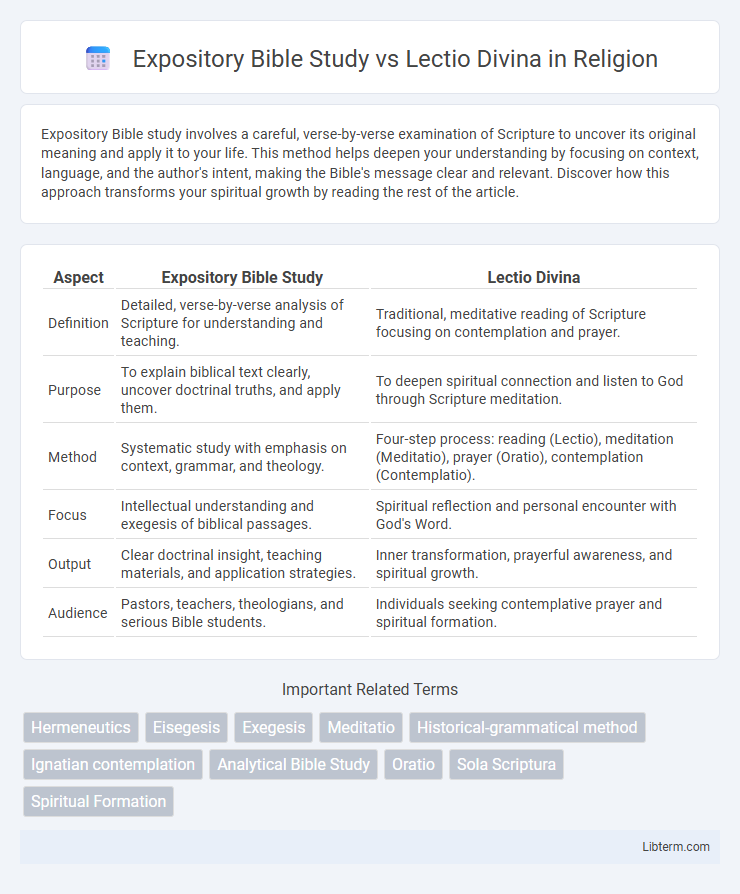Expository Bible study involves a careful, verse-by-verse examination of Scripture to uncover its original meaning and apply it to your life. This method helps deepen your understanding by focusing on context, language, and the author's intent, making the Bible's message clear and relevant. Discover how this approach transforms your spiritual growth by reading the rest of the article.
Table of Comparison
| Aspect | Expository Bible Study | Lectio Divina |
|---|---|---|
| Definition | Detailed, verse-by-verse analysis of Scripture for understanding and teaching. | Traditional, meditative reading of Scripture focusing on contemplation and prayer. |
| Purpose | To explain biblical text clearly, uncover doctrinal truths, and apply them. | To deepen spiritual connection and listen to God through Scripture meditation. |
| Method | Systematic study with emphasis on context, grammar, and theology. | Four-step process: reading (Lectio), meditation (Meditatio), prayer (Oratio), contemplation (Contemplatio). |
| Focus | Intellectual understanding and exegesis of biblical passages. | Spiritual reflection and personal encounter with God's Word. |
| Output | Clear doctrinal insight, teaching materials, and application strategies. | Inner transformation, prayerful awareness, and spiritual growth. |
| Audience | Pastors, teachers, theologians, and serious Bible students. | Individuals seeking contemplative prayer and spiritual formation. |
Understanding Expository Bible Study: Definition and Purpose
Expository Bible Study involves systematically examining Scripture by focusing on the original context, language, and meaning to uncover the intended message of the biblical text. Its purpose is to provide clear, accurate interpretation that informs belief and guides practical application. This method prioritizes detailed analysis of passage structure and theology to deepen understanding and promote sound doctrine.
What is Lectio Divina? Origins and Core Principles
Lectio Divina is an ancient Christian practice of scriptural reading, meditation, and prayer that originated in the early monastic tradition, particularly attributed to St. Benedict in the 6th century. Its core principles involve four steps: lectio (reading), meditatio (meditation), oratio (prayer), and contemplatio (contemplation), designed to deepen spiritual connection and understanding. Unlike expository Bible study, which emphasizes critical analysis and doctrinal exposition, Lectio Divina fosters an intimate, reflective engagement with Scripture, leading to personal transformation.
Historical Development of Expository Bible Study
Expository Bible Study has its roots in the Reformation era, where figures like Martin Luther and John Calvin emphasized the systematic explanation of Scripture to promote biblical literacy and doctrinal clarity. Over centuries, this method evolved into a disciplined approach that dissects the original language, context, and theology of biblical texts. In contrast to the meditative practice of Lectio Divina, Expository Bible Study aims to educate and equip believers by providing detailed, structured interpretations grounded in historical and grammatical analysis.
Historical Roots and Tradition of Lectio Divina
Lectio Divina, originating from the early Christian monastic tradition of the 4th century, emphasizes meditative and prayerful reading of Scripture, aiming to deepen spiritual communion with God. In contrast, Expository Bible Study, which developed later through Protestant Reformation principles, focuses on systematic, analytical examination of biblical texts to uncover doctrinal truths and practical applications. The ancient roots of Lectio Divina reflect a contemplative heritage, prioritizing experiential engagement with Scripture, while Expository Study embodies a more structured, academic approach to biblical interpretation.
Step-by-Step Process: Expository Bible Study
Expository Bible Study involves a systematic step-by-step process, starting with selecting a specific Bible passage to examine its context, meaning, and theological implications carefully. The method emphasizes detailed observation, interpretation based on original languages and biblical cross-references, followed by application that connects scriptural truths to daily life. This structured approach ensures a comprehensive understanding by integrating historical background, literary analysis, and doctrinal insights.
Step-by-Step Practice: Lectio Divina
Lectio Divina follows a four-step process: reading (lectio), meditation (meditatio), prayer (oratio), and contemplation (contemplatio), each designed to deepen spiritual connection through scripture. Practitioners begin by slowly reading a Bible passage, then reflect on its meaning, engage in prayer inspired by the text, and finally rest in silent contemplation to receive divine insights. This method contrasts with expository Bible study by emphasizing a prayerful, experiential interaction with scripture rather than analytical explanation.
Key Differences: Expository Bible Study vs Lectio Divina
Expository Bible Study emphasizes detailed, systematic examination of scripture, focusing on interpretation, context, and theological analysis to uncover the original meaning and application. Lectio Divina centers on meditative reading, prayerful reflection, and spiritual communion, inviting personal encounter and transformation through the text. The key difference lies in expository study's analytical approach versus Lectio Divina's contemplative, devotional practice.
Benefits and Limitations of Expository Bible Study
Expository Bible Study offers a thorough, verse-by-verse examination that promotes deep understanding of Scripture by emphasizing historical context, original language, and author intent, aiding in accurate theological interpretation. Its structured approach benefits systematic learning and doctrinal clarity but can become overly analytical, potentially limiting personal spiritual reflection and emotional engagement. Unlike Lectio Divina, which fosters contemplative meditation and a relational experience with the text, Expository Bible Study may lack the holistic spiritual nurturing found in more devotional practices.
Benefits and Challenges of Practicing Lectio Divina
Practicing Lectio Divina cultivates deeper spiritual reflection and a personal connection with Scripture, enriching one's understanding beyond the literal text. The method's contemplative nature promotes mindfulness and internal transformation but may present challenges for individuals seeking structured analysis or immediate theological clarity. Integrating Lectio Divina requires patience and openness to experiential learning, contrasting with the systematic approach characteristic of Expository Bible Study.
Choosing the Right Approach: Which Method Suits You?
Expository Bible study emphasizes systematic analysis and theological depth, ideal for those seeking comprehensive understanding and doctrinal clarity, while Lectio Divina focuses on contemplative reading and spiritual reflection, catering to individuals desiring intimate, prayerful engagement with Scripture. Selecting the right method depends on your spiritual goals: choose expository study for intellectual growth and structured learning, or Lectio Divina for meditative practice and personal transformation. Balancing both methods can also enrich your Bible study experience by combining analytical insight with devotional depth.
Expository Bible Study Infographic

 libterm.com
libterm.com